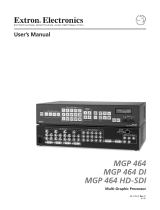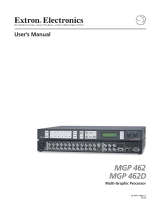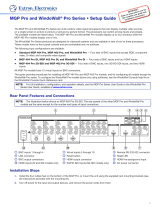Page is loading ...

Copyright © 2009 Vetus n.v. Schiedam Holland
Installatie instructies
Installation instructions
Installationsvorschriften
Instructions d’installation
Instrucciones de instalación
Istruzioni per l’installazione
NEDERLANDS 2
ENGLISH 4
DEUTSCH 6
FRANÇAIS 8
ESPAÑOL 10
ITALIANO 12
Waterlock
Waterlock
Wassersammler
Waterlock
Colector
Marmitte
MGP

4 030421.03
Waterlock MGP
Introduction
The Vetus exhaust system components are especially suitable
for use in water-injected exhaust systems.
The maximum continuous operating temperature of the plas-
tic components of the exhaust systems is 70 degrees C (158
degrees F).
The MGP waterlocks are available with the following intake
connections: 45° upward angle (standard), 30° upward angle
(on request), 15° upward angle (on request), and horizontal (on
request).
• Fit a temperature alarm to warn of excessively hot
exhaust system temperature
• If the quantity of injected coolant water is reduced to
in order to lower back-pressure in the exhaust system,
check that there is still sufficient water injected when
the engine is ticking-over. This will prevent excess tem-
peratures in the exhaust system
• Excess temperature can also be the consequence of
insufficient mixing of coolant water with the exhaust
gasses
In general, good mixing is obtained by a virtually verti-
cally installed exhaust injection bend
Poor mixing can also occur with an engine on tick-over;
especially when the coolant water injection bend is
installed virtually horizontally
If necessary, take action. For example; by fitting a water
vortex or a water splitter in the exhaust pipe, to improve
the mixing of coolant water with the exhaust gasses
With water-injected exhaust systems, fit a hose of suitable quality.
This hose must be reinforced, resistant to exhaust gasses, high
temperatures (100 degrees C, 212 degrees F) and oil. Easy
flexibility is essential for installation, while the hose must not
collapse when heated.
Vetus exhaust hose fulfils all the above requirements.
WARNING
If water enters the engine from the waterlock into the
exhaust system (for example: under sail when the ship
rolls or pitches heavily) this will lead to irreparable dam-
age to the engine.
Too much water in the waterlock can effect engine start-
ing; drain off this water first. Too much water in the water-
lock can be also caused by repeated starting attempts
while the engine refuses to start.
Installation
Installing waterlock MGP
Instal the waterlock as vertical as possible.
The waterlock ‘IN’-connection must always remain below the
level of the exhaust injection bend! Position the waterlock
‘back-to-front’ alongside the engine when there is insufficient
space behind the engine.
During operation, the waterlock will contain water. Its weight will
thus increase considerably.
Fit the waterlock on a level surface and attach it with M8 bolts
and 3D flat washers.
Installing the transom exhaust connection
Fit the transom exhaust connection at such a position that with
the ship fully laden, the outlet is still at least 5 cm (2”) above
the waterline.
Exhaust pipe
In order to ensure the proper drainage of the coolant water
injected into the exhaust pipe, the pipe must be installed with a
slope downward over its whole length from the water injection
point to the waterlock.
During operation, the exhaust pipe will contain water. This will
increase its weight considerably, so support the exhaust pipe
properly.
The exhaust pipe from waterlock to transom connection must
be installed in such a way that:
- The highest point in the exhaust pipe should not be more
than 150 cm (60”) above the underside of the waterlock.
- The length of the section between the waterlock and the
highest point, should not exceed 300 cm (120”).

030421.03 5
Waterlock MGP
ENGLISH
Hose connections
In to order to best connect the hose to the waterlock, the top
portion of the waterlock can be turned in a 360° radius.
The top portion should be turned as follows:
1 Loosen the clamping ring (A) by unscrewing the 8 M6 bolts
2 Pull the top portion of the waterlock upwards
3 Turn the top portion to the desired position
4 Let the top portion down again
5 Re-attach the clamping ring (A) by screwing the 8 M6 bolts
back in using a 2 Nm tightening torque.
Please note!
Ensure that the O-ring is properly centred!
Screw on the M6 bolts at the same time.
Make sure the top part is not out of position!
Fitting the hose
To ease the fitting of the hose to the hose connector, use only
water and/or soap, NOT grease or products containing oil.
Fit each hose connection with 2 stainless steel 12 mm (0.5”)
wide hose clamps.
Sensor for temperature alarm
A sensor for a temperature alarm can be fitted in the exhaust
pipe.
A sensor for a temperature alarm can also be fitted in the
exhaust silencer connector. The ‘IN’ connector on the exhaust
silencer has two circular areas. These are intended for fitting the
temperature sensor. Drill in one of these areas a hole of the cor-
rect size. Fit the sensor with a lock nut and, after fitting, check
that the exhaust silencer is completely liquid and gas-tight.
Installation example
On p. 15, you will find a depiction of an exhaust system with a
waterlock of type MGP and a transom exhaust connection.
When the engine is stopped, any water which is still in the
exhaust pipe (between the highest point in the exhaust system
and the waterlock) will run back to the waterlock.
Prevention of syphoning (drawing 2)
If the water injection point ‘C’ is below, or less than 15 cm (0.6”)
above the waterline (also when the ship heels under sail), there
is a risk that when the engine is stopped, the coolant water
will enter the engine due to syphoning. This syphoning can be
prevented in two ways:
By creating an air vent system in the coolant water hose
between engine block and water injection point ‘C’, by fitting
an air vent with air vent pipe, for example.
By fitting an air vent (with valve) in the coolant water hose
between the engine block and water injection point ‘C’.
Maintenance
Check all hose connections for gas and water leaks regularly.
Before the winter lay-up, drain the waterlock. The waterlock has
a drain plug for this purpose.

030421.03 11-09 (I.MGP) Printed in the Netherlands
vetus n. v.
FOKKERSTRAAT 571 - 3125 BD SCHIEDAM - HOLLAND - TEL.: +31 10 4377700
TELEFAX: +31 10 4372673 - 4621286 - E-MAIL: [email protected] - INTERNET: http://www.vetus.com
/



